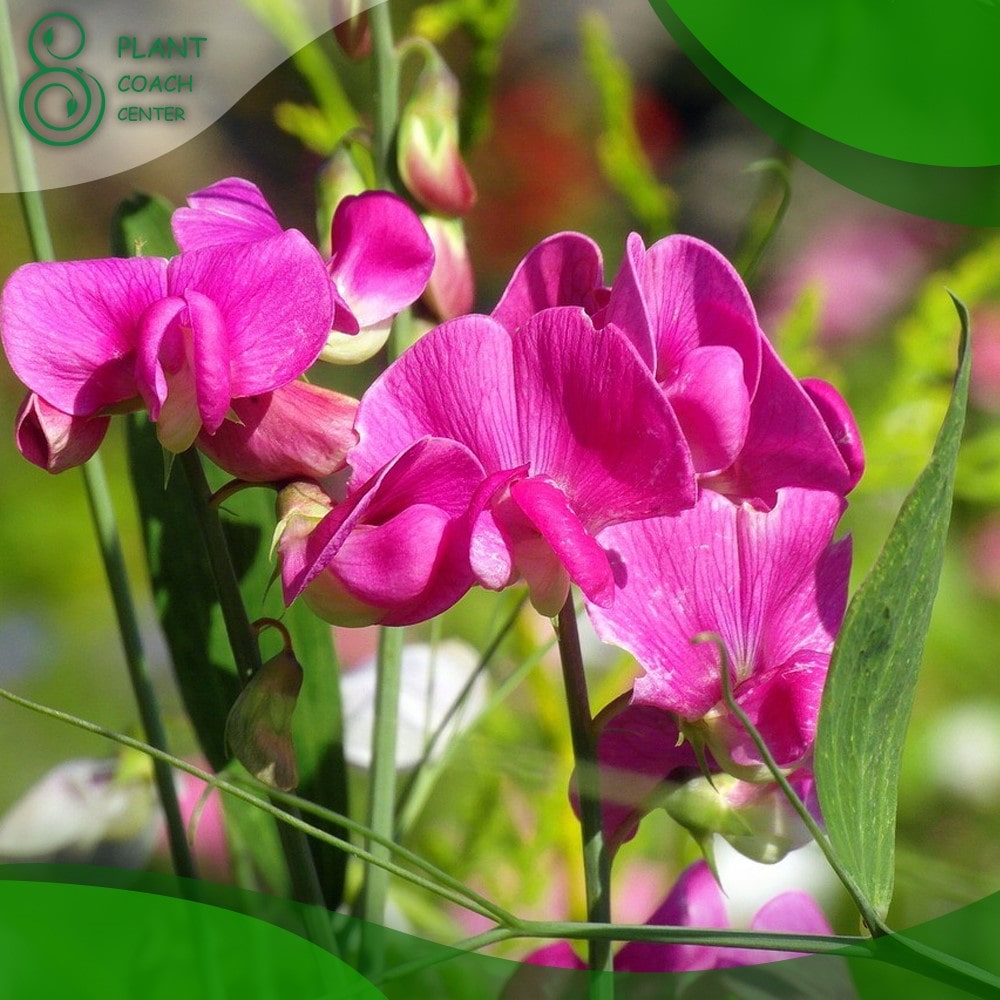When to Plant Out Sweet Peas
Sweet peas (Lathyrus odoratus) have long captivated gardeners with their delicate beauty and enchanting fragrance. Whether you’re a seasoned gardener or a beginner, understanding the optimal timing for planting out sweet peas is crucial for a successful growing season.
In this comprehensive guide, we will delve into the various aspects of sweet pea cultivation, including when and how to plant them, ideal growing conditions, troubleshooting common problems, and extending the blooming season. By the end of this article, you’ll have the knowledge and confidence to cultivate vibrant and fragrant sweet peas in your own garden.
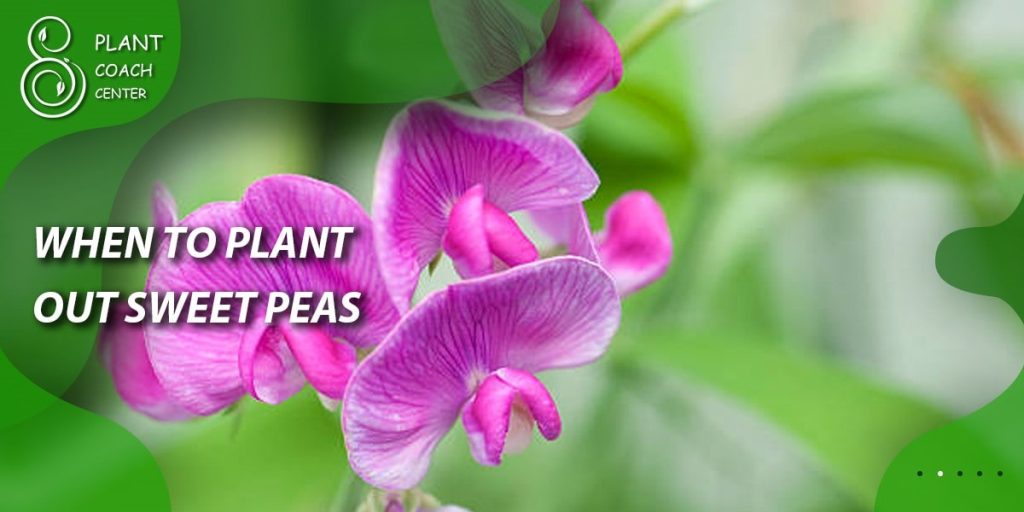
Understanding Sweet Peas
Brief History and Significance
Sweet peas have a rich history that dates back centuries. They were first discovered in the wild by Italian monk and botanist, Francisco Cupani, in the 17th century. Since then, breeders have tirelessly worked to develop new varieties with enhanced traits, leading to the diverse selection available today. Sweet peas gained popularity during the Victorian era, symbolizing delicate pleasures and expressing sentiments of blissful pleasure or goodbye. Even today, these charming flowers continue to evoke nostalgia and joy in gardens and floral arrangements.
Varieties of Sweet Peas
Over the years, breeders have developed a wide range of sweet pea varieties, each with its unique characteristics and growth habits. Some popular cultivars include ‘Spencer’ sweet peas, known for their large, ruffled flowers and long stems, and the highly scented ‘Old-Fashioned’ varieties. With an extensive selection available, you can choose from early-flowering types, heat-tolerant varieties, or those specifically bred for their dwarf or trailing habits.
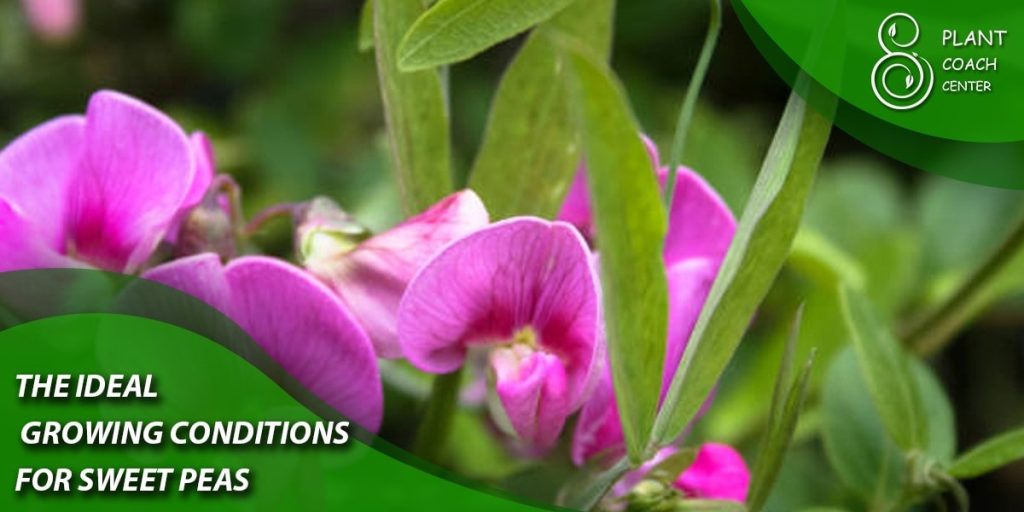
The Ideal Growing Conditions for Sweet Peas
To ensure healthy growth and abundant blooms, sweet peas require specific growing conditions. Let’s explore the key factors to consider when creating a favorable environment for your sweet pea plants.
Climate Requirements
Sweet peas thrive in cool to mild climates, preferring temperatures between 50°F (10°C) and 70°F (21°C). They are typically grown as annuals in regions with hot summers and frosty winters. However, in areas with mild winters, sweet peas can be grown as winter annuals or even as perennials.
Soil Preferences
Well-draining soil is essential for sweet peas, as they are susceptible to root rot in waterlogged conditions. Ideally, the soil should be rich in organic matter and have a slightly acidic to neutral pH level ranging from 6.0 to 7.0. Before planting, loosen the soil and incorporate compost or well-rotted manure to improve its fertility and structure.
Sunlight and Shade Considerations
Sweet peas thrive in full sun, receiving at least six hours of direct sunlight per day. However, in regions with scorching summers, providing some afternoon shade can help prevent stress and prolong the blooming period. Consider planting sweet peas near taller plants or structures that can offer partial shade during the hottest part of the day.
Watering Needs
Consistent moisture is crucial for sweet peas, especially during their flowering period. However, it’s important to strike a balance and avoid overwatering, which can lead to root issues. Water deeply when the top inch of soil feels dry, ensuring thorough saturation of the root zone. Mulching around the plants can help retain moisture and regulate soil temperature.
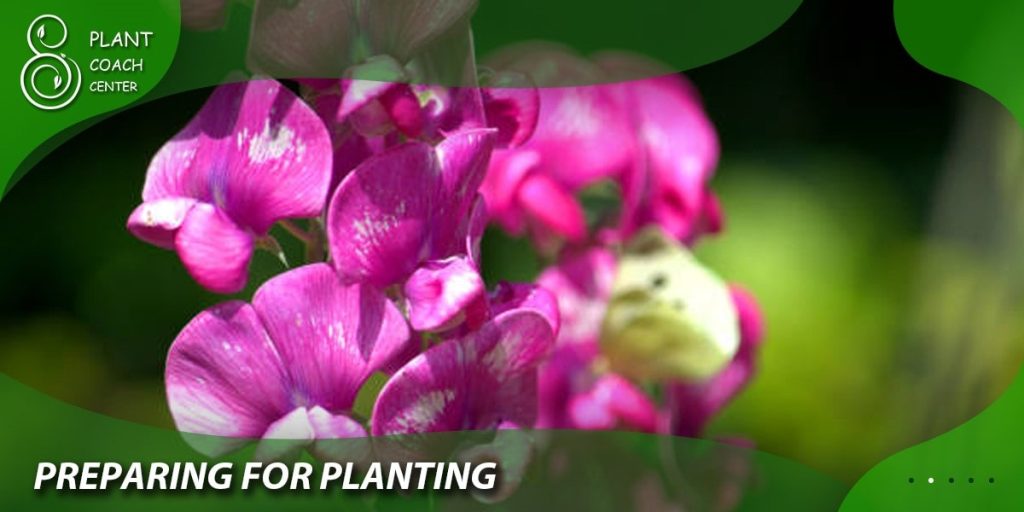
Preparing for Planting
Before you plant out your sweet peas, it’s essential to make the necessary preparations to set them up for success.
Seed Selection and Quality
When selecting sweet pea seeds, opt for reputable sources that offer high-quality, fresh seeds. Look for varieties that suit your preferences in terms of color, fragrance, and growth habit. Ensure that the seeds are within their viability period, as older seeds may have reduced germination rates.
Germination Techniques
Sweet peas have hard seed coats, which benefit from scarification or soaking before sowing to enhance germination. Scarification involves lightly nicking or filing the seed coat to break its hard exterior. Alternatively, you can soak the seeds in room temperature water for 24 hours before planting. This process helps soften the seed coat and encourages faster germination.
Importance of Timing
Timing plays a crucial role in sweet pea cultivation. It’s important to sow the seeds at the right time to ensure optimal growth and flowering. The timing will vary depending on your location and climate zone. In general, sweet peas are typically planted in early spring, a few weeks before the last frost date. However, in milder regions, they can be sown in late winter or early fall for winter or early spring blooms.
Factors Affecting Planting Time
Several factors can influence the timing of planting sweet peas:
- Climate Zone: Identify your climate zone to understand the general patterns of temperature and frost in your region. This information will serve as a guide for determining the appropriate planting time.
- Variety Characteristics: Different sweet pea varieties have varying growth rates and temperature preferences. Some may be more cold-tolerant, while others thrive in milder conditions. Consider the specific requirements of the varieties you intend to grow.
- Desired Blooming Period: Determine when you want your sweet peas to bloom. If you aim for early spring blooms, you’ll need to plant earlier than those aiming for summer or fall flowers.
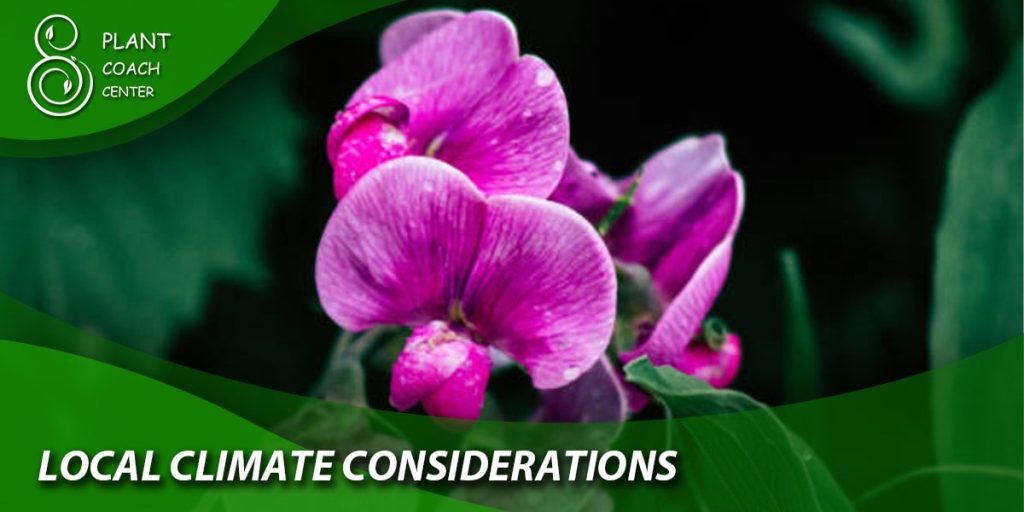
Local Climate Considerations
Understanding your local climate is crucial for successful sweet pea cultivation. Consider the following aspects:
- Average Frost Dates: Determine the average date of the last spring frost in your area. This information will help you plan when to plant your sweet peas, as they are susceptible to frost damage.
- Microclimates: Assess any microclimates in your garden or surrounding areas. These localized variations in temperature can significantly impact the success of your sweet peas. For instance, south-facing walls or sheltered spots may provide slightly warmer conditions, allowing for earlier planting.
Regional Variations in Planting Dates
It’s important to note that planting dates can vary based on regional climate variations and specific local conditions. Factors such as altitude, proximity to bodies of water, and prevailing weather patterns can influence planting recommendations.
Temperature Monitoring
- Thermometer: Invest in a reliable outdoor thermometer to monitor daily temperature fluctuations. Place it in a location that accurately represents the conditions where you plan to grow your sweet peas.
- Minimum Temperature Tolerance: Different sweet pea varieties have varying tolerance to low temperatures. Refer to the seed packets or consult gardening resources to determine the minimum temperature at which your chosen varieties can safely tolerate. Avoid planting out your sweet peas if the temperatures are below their tolerance level.
Weather Forecast
- Local Weather Reports: Regularly check local weather reports for temperature forecasts, frost warnings, and extreme weather conditions. This information can help you anticipate and plan for any unfavorable weather that may affect your sweet peas.
- Watch for Frost Warnings: Pay close attention to frost warnings, especially during the early stages of planting. If frost is predicted, take necessary precautions to protect your sweet peas, such as covering them with frost blankets or temporarily moving potted plants indoors.
Soil Temperature
- Soil Thermometer: Consider using a soil thermometer to monitor the temperature at the root zone. This can provide valuable insights into the soil’s readiness for planting. Sweet peas prefer soil temperatures between 50°F (10°C) and 60°F (15°C) for optimal germination and root development.
- Warm-Up Period: If the soil temperature is too cold, consider waiting until it warms up to the desired range before planting out your sweet peas. Pre-warming the soil using techniques like black plastic mulching or cloches can help accelerate the warming process.
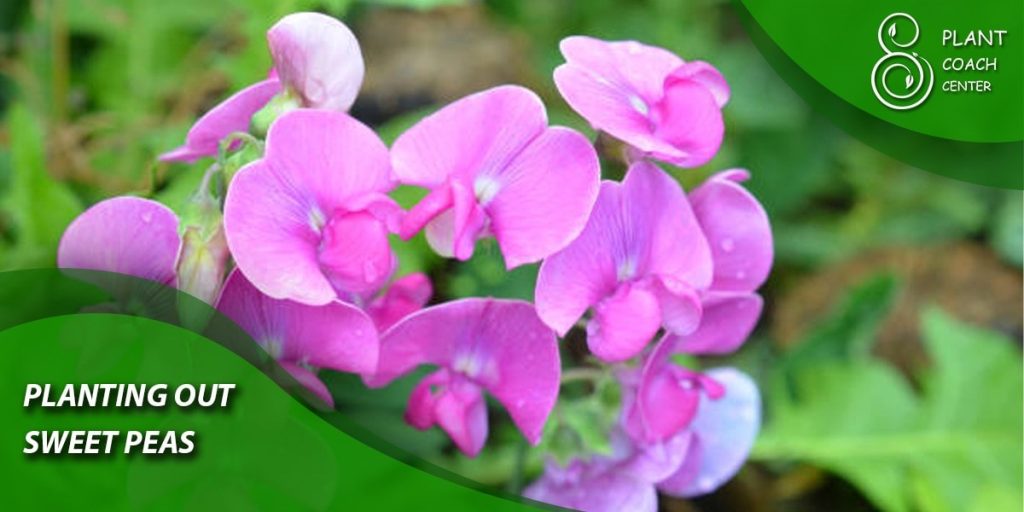
Planting Out Sweet Peas: Step-by-Step Guide
Planting out sweet peas can be done through direct sowing or by transplanting seedlings. Here’s a step-by-step guide that covers both methods:
Direct Sowing Method
- Prepare the Soil: Choose a sunny location with well-draining soil. Loosen the soil to a depth of about 12 inches (30 cm), removing any weeds or debris. Incorporate organic matter such as compost or well-rotted manure to improve soil fertility.
- Scarify or Soak the Seeds: Sweet pea seeds have hard seed coats, which benefit from scarification or soaking to enhance germination. Lightly nick the seed coat or soak the seeds in room temperature water for 24 hours before planting.
- Create Furrows: With a garden trowel or your finger, create furrows in the prepared soil. The furrows should be about 1 inch (2.5 cm) deep and 6 to 8 inches (15 to 20 cm) apart.
- Plant the Seeds: Place the scarified or soaked seeds in the furrows, spacing them about 2 inches (5 cm) apart. Cover the seeds with soil and gently firm it down.
- Water and Mulch: Water the newly planted seeds thoroughly but gently to settle the soil. Apply a layer of organic mulch, such as straw or wood chips, to help retain moisture and suppress weed growth.
Transplanting Seedlings Method
- Start Seeds Indoors: Begin by starting sweet pea seeds indoors 4 to 6 weeks before the intended planting out date. Sow the seeds in individual containers filled with seed-starting mix, following the recommended depth on the seed packet.
- Provide Optimal Conditions: Place the seed trays or pots in a warm location, maintaining a temperature of around 65°F to 70°F (18°C to 21°C). Provide ample sunlight or use grow lights to ensure healthy seedling growth.
- Harden Off Seedlings: About a week before the planting out date, gradually acclimate the seedlings to outdoor conditions. Start by placing them outdoors in a sheltered spot for a few hours each day, gradually increasing the duration and exposure to direct sunlight.
- Prepare the Planting Site: Choose a well-prepared garden bed with fertile, well-draining soil in a sunny location. Dig holes that are slightly larger than the root balls of the seedlings, spacing them 6 to 8 inches (15 to 20 cm) apart.
- Plant Seedlings: Gently remove the seedlings from their containers, being careful not to disturb the roots. Place each seedling in a planting hole and backfill with soil, ensuring that the top of the root ball is level with the soil surface.
- Water and Mulch: Water the newly transplanted seedlings thoroughly to settle the soil around the roots. Apply a layer of organic mulch around the plants, maintaining a gap around the stems to prevent moisture-related issues.
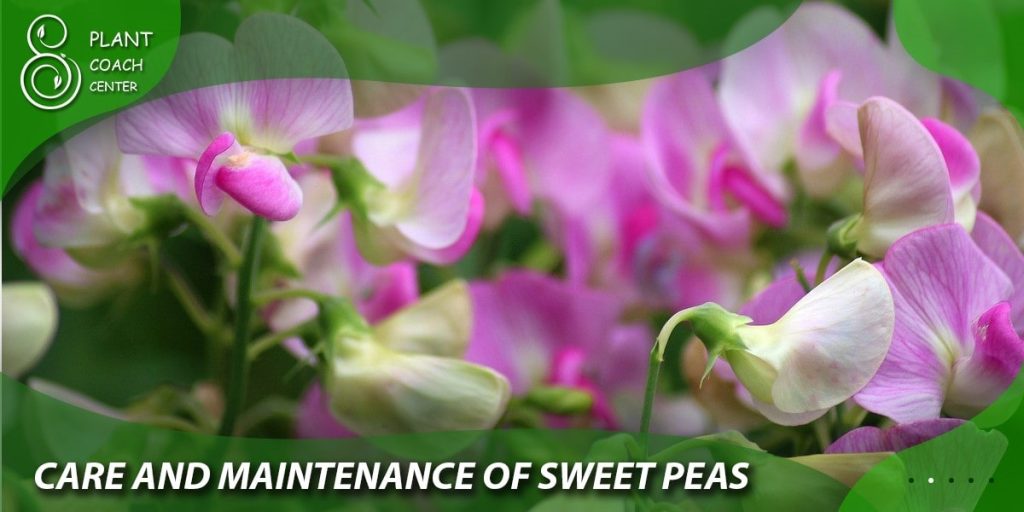
Care and Maintenance of Sweet Peas
Proper care and maintenance are crucial for the healthy growth and blooming of sweet peas. Here are some essential tasks to consider:
Watering
- Regular Watering: Sweet peas require consistent moisture throughout their growing season. Water the plants regularly, aiming to keep the soil evenly moist but not waterlogged. Monitor the soil moisture level and adjust watering frequency based on weather conditions.
- Avoid Overhead Watering: To prevent foliar diseases and fungal issues, avoid watering the foliage. Instead, focus on watering the soil at the base of the plants.
Fertilizing
- Pre-Planting Fertilization: Prior to planting, incorporate a balanced, slow-release fertilizer into the soil according to the manufacturer’s instructions. This helps provide essential nutrients for the growing plants.
- Side-Dressing: As the sweet peas grow, side-dress them with a balanced fertilizer, such as a granular 10-10-10 or a liquid fertilizer formulated for flowering plants. Apply the fertilizer according to package instructions, taking care not to let it come into direct contact with the plant’s leaves.
Mulching and Weed Control
- Mulching: Maintain a layer of organic mulch, such as straw or wood chips, around the base of the sweet pea plants. Mulching helps conserve moisture, suppresses weed growth, and regulates soil temperature.
- Weed Control: Regularly inspect the planting area and remove any weeds that compete with the sweet pea plants for resources. Be cautious while weeding to avoid damaging the shallow roots of the sweet peas.
Supporting the Vines
- Install Supports: Sweet peas are climbing vines that require support for optimal growth. Install trellises, stakes, or other support structures at the time of planting or shortly after. This allows the vines to attach and climb as they grow.
- Training and Tying: As the sweet pea vines grow, gently train them to climb the supports. Use soft ties, twine, or plant clips to secure the vines to the support structure, ensuring they have enough space to grow without becoming overcrowded.
Pest and Disease Management
- Pest Monitoring: Regularly inspect the sweet pea plants for common pests such as aphids, slugs, and snails. If you notice an infestation, use appropriate pest control methods, such as handpicking, insecticidal soaps, or organic pest deterrents.
- Disease Prevention: To minimize the risk of diseases, provide good air circulation around the plants by spacing them adequately. Avoid overhead watering, as it can promote foliar diseases. If necessary, apply appropriate fungicides according to the instructions if you observe signs of disease.
Deadheading and Pruning
- Deadheading: Remove faded or spent flowers regularly by pinching or cutting them off just above a set of healthy leaves. Deadheading encourages continued blooming and prevents the plants from diverting energy into seed production.
- Pruning: Sweet peas can benefit from occasional pruning to maintain a tidy appearance and encourage branching. Pinch back the tips of the vines when they reach about 6 inches (15 cm) in length to promote bushier growth.
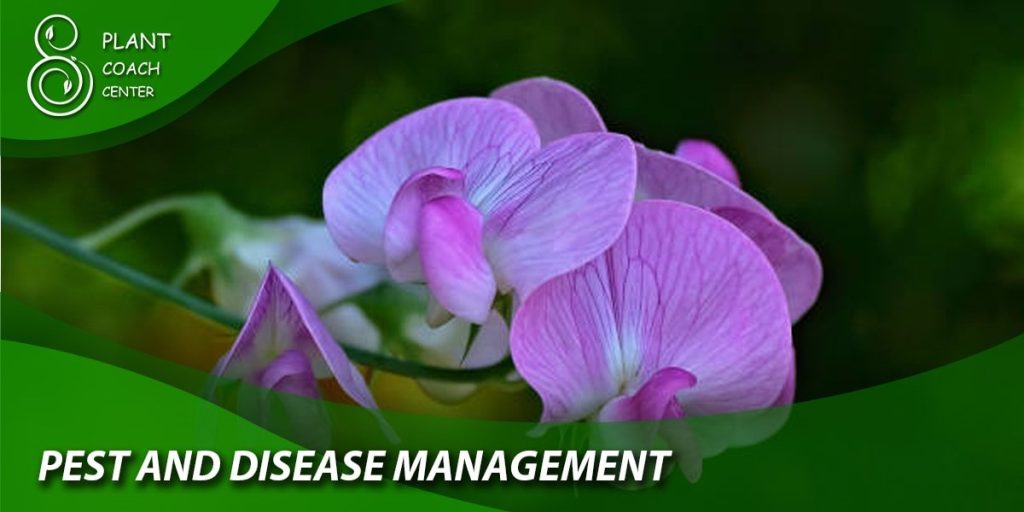
Conclusion
successful sweet pea cultivation involves monitoring temperature and weather patterns, choosing the appropriate planting method (direct sowing or transplanting seedlings), and providing proper care and maintenance. By monitoring temperature and weather conditions, you can make informed decisions about when to plant out your sweet peas, ensuring they are not subjected to unfavorable conditions.
Direct sowing involves scarifying or soaking the seeds and planting them in furrows, while transplanting seedlings requires starting seeds indoors and gradually acclimating them to outdoor conditions before planting in well-prepared garden beds.
Proper care and maintenance include regular watering, avoiding overhead watering to prevent foliar diseases, fertilizing to provide essential nutrients, mulching to conserve moisture and suppress weeds, installing supports for the climbing vines, monitoring and managing pests and diseases, and performing deadheading and pruning to encourage continuous blooming and maintain plant health.


